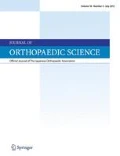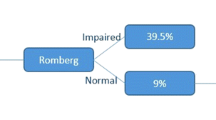Abstract
Background
Maintaining or improving motor (balance) ability is essential to extending the healthy lifespan of elderly people, and developing effective and efficient strategies to prevent falls of elderly people is an urgent. The purpose of this study was to determine the effects of balance exercise on fall and fracture prevention for elderly people with poor balance.
Methods
A 6-month, randomized controlled trial was conducted to verify whether one-leg standing with eyes open for a total of 1 min, three times a day (dynamic flamingo exercise) prevents falls and fractures. Setting and participants were elderly people ≥75 years of age and one-leg standing time ≤15.0 s living in their own home. They were visiting orthopaedic clinics for orthopaedic handicaps. Subjects with poor balance were allowed to hold on to something. If a subject’s lifted leg touched the ground during the exercise, they were allowed to lift it again and continue so that they stood on one leg for a total of 60 s.
Results
The dynamic flamingo exercise group (410 people; 86 men, 324 women) and the no exercise group (455 people; 78 men, 377 women) were compared. After dynamic flamingo exercise for 6 months, significant differences were seen in the increase in one-leg standing time with eyes open (men right/left, women right/left), in the improvement in independence in daily living (women), number of people who fell during the 6 months (women), and adverse events (women). The number of fractures was not significantly different for men or women.
Conclusions
Dynamic flamingo exercise prevents falls but no significant difference was demonstrated in fracture prevention in elderly women with poor balance.

Similar content being viewed by others
References
Miller CW. Survival and ambulation following hip fracture. J Bone Joint Surg Am. 1978;60:930–4.
de Palma L, Rizzi L, Lorini G, Greco F. Survival after trochanteric fracture. Biological factors analyzed in 270 patients. Acta Orthop Scand. 1992;63:645–7.
Sakamoto K, Nakamura T, Hagino H, Endo N, Mori S, Muto Y, Harada A, Nakano T, Yamamoto S, Kushida K, Tomita K, Yoshimura M, Yamamoto H. Report on the Japanese Orthopaedic Association’s 3-year project observing hip fractures at fixed-point hospitals. J Orthop Sci. 2006;11:127–34.
Lord SR, Ward JA, Williams P. J. An epidemiological study of falls in older community-dwelling women: the Randwick falls and fractures study. Austr J. Public Health. 1993;17:240–5.
Cripps R, Carman J. 2. Hospitalisations due to accidental falls. Falls by the elderly in Australia: trends and data for 1998. Canberra, Australia: Australian Institute of Health and Welfare, 2001;1–9.
Sherrington C, Whitney JC, Lord SR, Herbert RD, Cumming RG, Close JCT. Effective exercise for the prevention of falls: a systematic review and meta-analysis. JAGS. 2008;56:2234–43.
Robertson MC, Devlin N, Gardner MM, Campbell AJ. Effectiveness and economic evaluation of a nurse delivered home exercise programme to prevent falls. 1: randomised controlled trial. BMJ. 2001;322:697–701.
Haeney RP. Chapter 6 calcium, bone health, and osteoporosis (Peck WA editor). Bone Miner Res. 1986;4:255–301.
Sibonga JD, Evans HJ, Sung HG, Spector ER, Lang TF, Oganov VS, Bakulin AV, Shackelford LC, LeBlanc AD. Recovery of spaceflight-induced bone loss: bone mineral density after long-duration missions as fitted with an exponential function. Bone. 2007;41:973–8.
Turner CH. Three rules for bone adaptation to mechanical stimuli. Bone. 1998;23:399–407.
Sakamoto K, Tashiro Y, Sato Y, Sugimoto F, Kawasaki K, Honmo J, Yamaguchi A, Fujimaki E. Dynamic flamingo therapy for reducing of femoral neck fracture—a preliminary study. Bone. 1995;16(Suppl):164S.
Sakamoto K, Sugimoto F, Sato Y, Fujimaki E, Tashiro Y. Dynamic Flamingo Therapy for prevention of femoral neck osteoporosis and fractures-part 1: theoretical background-Showa. Med Sci. 1999;11:247–54.
Wolf SL, Bamhart HX, Kutner NG, McNeely E, Coogler C, Xu T and the Atlanta FICSIT Group. Reducing frailty and falls in older persons: an investigation of Tai Chi and computerized balance training. JAGS. 1996;44:489–97.
Campbell AJ, Robertson MC, Gardner MM, Norton RN, Tilyard MW, Buchner DM. Randomized controlled trial of a general practice programme of home based exercise to prevent falls in elderly women. BMJ. 1997;315:1065–9.
Sakai A, Oshige T, Zenke Y, Yamanaka Y, Nagaishi H, Nakamura T. Unipedal standing exercise and hip bone mineral density in postmenopausal women: a randomized controlled trial. J Bone Miner Metab. 2010;28:42–8.
Sakamoto K, Tashiro Y. Protective exercise for osteoporosis—unipedal standing exercise. J Phys Med. 2005;16:2–7 (in Japanese).
Schulz KF, Altman DG, Moher D, for the CONSORT Group. CONSORT. Statement: updated guidelines for reporting parallel group randomized trials. BMJ. 2010;2010(340):698–702.
Liberman U, Weiss SR, Brőll J, Minne HW, Quan H, Bell NH, Rodriguez-Portales J, Downs Jr RW, Dequeker J, Favus M, Seeman E, Recker RR, Capizzi T, Santora II AG, Lombardi A, Sah RV, Hirsch LJ, Karpf D. For the Alendronate Phase III Osteoporosis Treatment Study Group. Effect of oral alendronate on bone mineral density and the incidence of fractures in postmenopausal osteoporosis. N Engl J Med. 1995;333:1437–43.
Reid DM, Hughes A, Laan RFJM, Sacco-Gibson NA, Wenderoth DH, Adami S, Eusebio RA, Devogelaer J-P. Efficacy and safety of daily risedronate in the treatment of corticosteroid-induced osteoporosis in men and women: a randomized trial. J Bone Miner Res. 2000;15:1006–13.
Shiraki M, Kushida K, Yamazaki K, Nagai T, Inoue T, Orimo H. Effects of 2 years’ treatment of osteoporosis with 1 α-hydroxy vitamin D3 on bone mineral density and incidence of fracture: a placebo-controlled double-blind prospective study. Endocr J. 1996;43:211–20.
Hayashi Y, Fujita T, Inoue T. Decrease of vertebral fracture in osteoporosis by administration of 1α-hydroxy-vitamin D3. J Bone Miner Metab. 1992;10:184–8.
Kanis JA, Johansson H, Oden A, McCloskey EV. Bazedoxifene reduces vertebral and clinical fractures in postmenopausal women at high risk assessed with FRAX. Bone. 2009;44:1049–54.
Silverman S, Christiansen C, Genant HK, Vukicevic S, Zanchetta JR, de Villiers TJ, Constantine GD, Chines A. Efficacy of bazedoxifene in reducing new vertebral fracture risk in postmenopausal women with osteoporosis: results from a 3-year, randomized, placebo, and active-controlled clinical trial. J Bone Miner Res. 2008;23:1923–34.
McMurdo ME, Millar AM, Daly F. A randomized controlled trial of fall prevention strategies in old peoples’ homes. Gerontology. 2000;46:83–7.
Mulrow CD, Gerety MB, Kanten D, Cornel JE, DeNino LA, Chiodo L, Aguilar C, O’Neil MB, Rosenberg J, Solis RM. A randomized trial of physical rehabilitation for very frail nursing home residents. JAMA. 1994;271:519–24.
Province MA, Hadley EC, Hornbrook MC, Lipsitz LA, Miller JP, Mulrow CD, Ory MG, Sattin RW, Tinetti ME, Wolf S, for the FICSIT Group. The effects of exercise on falls in elderly patients. JAMA. 1995;273:1341–7.
Campbell AJ, Robertson MC, Gardner MM, Norton RN, Buchner DM. Falls prevention over 2 years: a randomized controlled trial in women 80 years and older. Age Ageing. 1999;28:513–8.
Kasahara M, Yamasaki H, Aoki U, Yokoyama H, Omori Y, Hiraki K. Relationship between one leg standing time and knee extension strength in elderly patients. Jpn J Phys Fitness Sports Med. 2001;50:369–74 (in Japanese).
Michikawa T, Nishiwaki Y, Takebayashi T, Toyama Y. One-leg standing test for elderly populations. J Orthop Sci. 2009;14:675–85.
Sakai A, Toba N, Takeda M, Suzuki M, Abe Y, Aoyagi K, Nakamura T. Association of unipedal standing time and bone mineral density in community-dwelling Japanese women. Osteoporos Int. 2009;20:731–6.
Acknowledgments
The authors would like to thank all of the staff members of the clinics and hospitals that cooperated in this study and the following investigators and clinical sites: Ootaka Y, Tokyo Wangan Rehabilitation Hospital; Ishii K, Yorou Clinic; Sakata T, Kitade Hospita; Ishikawa H, Aichi Health Promotion Foundation; Nakamura K, Shinagawa Health and Human Service Centre; Uchino S and Suzuki T, Santoku-Kai; and Nagai T, Showa University. Funding: This study was partially supported by a Grant-in-Aid from the Ministry of Health, Labour, and Welfare of Japan (grants H19-Choujyu Ippan-031).
Conflict of interest
The authors declare no conflict of interest related to this study.
Author information
Authors and Affiliations
Corresponding author
Additional information
Supported by a grant-in-aid from the Ministry of Health, Labour, and Welfare of Japan (grants H19-Choujyu Ippan-031).
An erratum to this article is available at http://dx.doi.org/10.1007/s00776-014-0531-5.
Appendix: Principal Clinical sites
Appendix: Principal Clinical sites
Furukawabashi Hospital, Kimuramorokado Hospital, Takatsu Chuoh Hospital, Kamiitabashi Dai2 Hospital, Nishikamata Clinic, Kyoudou Clinic, Kuchiishi Hospital, Kobayashi Clinic, Tsurumaki Orthopaedic Clinic, Sawatari Clinic, Kayama Orthopaedic Clinic, Musashiyamato Orthopaedic Clinic, Suzuki Orthopaedic Clinic, Sekimizu Orthopaedic Clinic, Central Hospital, Sakura Orthopaedic & Rehabilitation Hospital, Fukuzawa Orthopaedic Clinic, Furuoka Orthopaedic Clinic, Maeda Hospital, Yoshimura Orthopaedic Clinic, Chouritu Ogano Central Hospital, Tomakomai Hospital, Toyooka-Central Hospital, Hirosaki City Hospital, Iwate Medical University, Tokyo Kyousai Hospital, Yonehara-Central Hospital, Tokyo Jikeikai Medical University, Toho University Oohashi Hospital, Tokyo Metropolitan Rehabilitation Hospital, Kugayama Hospital, Washiya Hospital, Dokyou Medical University, Rounenbyo-Kenkyusyo Hospital, Shirogane Orthopaedic Hospital, Kikkouman Clinic, Shinnkawabashi Hospital, Yamanashi Prefectural Hospital, Nirasaki City Hospital, Fukui University, Gifu University, Ohgaki Central Hospital, Kouritu Morinomachi Hospital, Mie University, Yamada Orthopaedic Hospital, Maizuru Red-Closs Hospital, PL Hospital, Saiseikai Suita Hospital, Kinki University Sakai Hospital, Kobe 100 Nen Kinen Hospital, Kouritu Toyo-oka Hospital, Hyougo Medical University, Mimuro Prefectural Hospital, Nara Rehabilitation Centre, Misasa Onsen Hospital, Sanin Rosai Hospital, Kaike Onsen Hospital, Okayama University, Cyugoku Denryoku Hospital, Kosei Sogou Hospital, Kagawa Rosai Hospital, Tosa City Hospital, University of Occupational and Environmental Health, Sinal Cord Injury Centre, Kawashima Orthopaedic Hospital, Ohita Orthopaedic Hospital, Kumamoto University, Miyazaki University, Nichinan Hospital, Komaki Hospital, Iida Hospital, Showa University, Kouritsu Tan-Nan Hospital, Showa University Yokohama Hokubu Hospital, Hiraosaki Kinenn Hospital, Teikyou University Chiba Medical Centre, Shiota Sogo Hospital, Sekigawara Hospital, Tsusima City Hospital, Minamikawa Orthopaedic Hospital, Isahaya Sogo Hospital, Tkachiho-Mmachi Hospital, Kusimaoto Hospital, Momotake Orthopaedic Hospital, Kumamoto Kino Hospital, Kitade Hospital, Uguisu-Yado Onsen Hospital, Hachiya Orthopaedic Hospital, Yonago Medical Centre, Seibu Shimane Medical Centre, Hiroshima Tetsudo Hospital, Moji Rosai Hospital, Kimachi Rehabilitation Hospital, Ohta Sogo Hospital, Sapporo Eikeigeka-Jyunkanki Hospital, Aomaori Prefectural Hamanasu Medical Centre, Edogawa Hospital, Gamagouri City Hospital, Suga Orthopaedic Hospital, Tamana Central Hospital, Kijima Orthopaedic Clinic, Seigo Clinic, Niigata Rehabilitation Hospital, Nakamura Orthopaedic Clinic, Murai Orthopaedic Hospital, Noto Orthopaedic Clinic, Nakayama Orthopaedic Clinic, Asai Orthopaedic Clinic, Yanagi Orthopaedic Clinic, Kojima Orthopaedic Clinic, Ishizaka Orthopaedic Clinic, YUkiyoshi Clinic, Takahashi Orthopaedic Clinic, Ohkawa Clinic, Motomachi Hospital, Iwate Medical University Hanamaki Onsen Hospital, MIzuhara-Go Hospital, Nissan Tamagawa Hospital, National Center for Geriatrics and Gerontology, Tomizawa Hospital, Sato Hospital, Ehime National Hospital, Ishikawa Prefectural Central Hospital, Chikuma Central Hospital, Ohta Hospital, Mazda Hospital, Ube Kyouritu Hospital, Yokohama City University, Kusunoki Orthopaedic Clinic, Nezu Orthopaedic Clinic, Kubota Orthopaedic Clinic, Saiseikai Otaru Hospital, National Hirosaki Hospital, Sanai Hoppital, Yamanaka Onsen Hospital, Sakasita Hospital, Yoshida Orthopaedic Clinic, Jinsen Onsen-Kaigo Rehabilitation, Suzuka Central Hospital, National Kochi Hospital, Ohita Jyunkannki Hospital, Honma Orthopaedic Clinic, Ishii Clinic, Niigata Prefectural Kamo Hospital, Kuwana Hospital, Nishi Niigata Central Hospital, Akishima Hospital, Namekawa Hospital, Kita Orthopaedic Clinic, Sanyudo Hospital, Yonago Higashi Hospital, Tama Hokubu Medical Centre, Ohdate City Hospital, Mirai Orthopaedic & Pain Clinic, Saku-Daira Orthopaedic Clinic, Minano Hospital, Hiramatu Orthopaedic Clinic, Kurata Hospital, Yourou Orthopaedic Clinic, Takeda Orthopaedic Clinic, Nakane Orthopaedic Clinic, Kanematsu Orthopaedic Clinic, Ebihara Hospital, Tama Medical Rehabilitation Clinic, Nasu Orthopaedic Clinic, Kichikawa Orthopaedic Clinic, Nagata Clinic, Hirose Clinic, Honda Orthopaedic Clinic, Mikami Orthopaedic Clinic and Mori Orthopaedic Clinic.
About this article
Cite this article
Sakamoto, K., Endo, N., Harada, A. et al. Why not use your own body weight to prevent falls? A randomized, controlled trial of balance therapy to prevent falls and fractures for elderly people who can stand on one leg for ≤15 s. J Orthop Sci 18, 110–120 (2013). https://doi.org/10.1007/s00776-012-0328-3
Received:
Accepted:
Published:
Issue Date:
DOI: https://doi.org/10.1007/s00776-012-0328-3




